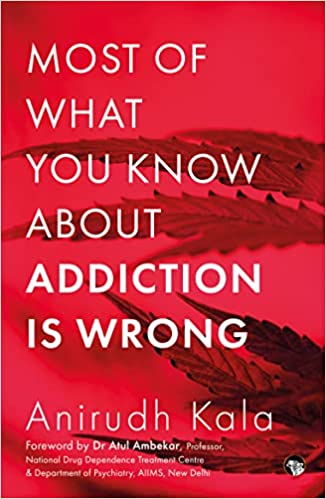
Addiction and abstinence are two extremes of the spectrum. Addiction is a consequence of pursuit of unbridled high while abstinence is about denial of the pleasure principle. Chemical addiction doing drugs, hogs the attention of press, police and politicians. Almost everyone has an opinion on addiction and Dr.Kala Feels most of it is wrong. The book goes on to prove his assumption.
It is to be soon translated in Punjabi, is written for lay people and policy makers. The book in 13 chapters covers relevant topics cogently. The first chapter is about antiquity of the practice of consuming narcotics and psychotropics. Cultivation of opium in West Asia dates back to 8000 years. The usage of opium, cannabis and other intoxicating agents was common in India. Cannabis has a religious sanction Shiva the revered God himself consumes it. The use of opium and cannabis as medication appears in early text books. The mughals used it, Nihang Sikhs, Yogis travelling mendicants used cannabis and opium, the nomadic mendicants consume cannabis. There are many more tribes and sects who indulge in ritualistic consumption of ‘bhang’. Dr. Thomas Sydenham popularized the use of laudanum in England. It contained opium dissolved in alcohol. It was an instant hit. It was used in the clinics as. Injectable morphine an effective analgesics became a source of intoxication and addiction. Many other narcotic analgesics like pethidine, morphine and buprenorphine are common chemicals with addicts. First two chapters trace the evolution of usage of psychotropics since the early days of human settlement. This is followed by discussion on addiction as a personal failing and its social context.
Punjab is infamous for being drug capital of India. Punjab which emerged as the food basket of India attracted many immigrants from staes like Bihar and U.P. These immigrants continued their native habit of consuming cannabis and opium which added to the numbers of Punjab. Punjabis who reaped the benefit of green revolution have seen a decline in fortunes for various reasons. Culture of drug flourishes in the times of distress. Agrarian distress acted as a trigger for drug abuse. Politicians instead of addressing economic distress and societal breakdown come up with inane slogans like ‘Say No To Drugs’. Politicians look at the problem of drug misuse as an opportunity to decimate opposition. Numbers and stastics are misinterpreted either knowingly or out of ignorance. The book deals with all these issues succinetly. Commonly used drugs both oral and injectable are discussed very briefly, just enough for the lay reader to understand nature of drugs commonly consumed.
There are many misconceptions when it comes to addiction and drug abuse. Addiction is almost always linked to opium, cannabis, heroin and so forth. Addiction to alcohol, tobacco rarely evoke a similar opprobrium. It is also believed that women are less susceptible to addiction which is not true. It is also generally believed that easy availability of drugs necessarily increases the chances of addiction and abuse again not a complete picture. These myths are discussed effectively. In chapter 6, commonly used drugs like alcohol, tobacco, opioids, inhalants, sedatives, cocaine, amphetamine and other hallucinogens are discussed briefly. Bar graph on page 78, (Figures, notes and tables are not numbered) effectively shows harm caused by various drugs. There is also a mention of the nation family health survey conducted by the ministry of health and welfare (2019-2021) which shows that there are more problems due to prohibition in the states of Bihar, Gujarat, Mizoram and Nagaland than solving the problems of addiction. The important take away as suggested by the author are “Alcohol and tobacco (not heroin, cocaine or cannabis) are the two most addictive as well as the most medically harmful intoxicants”. Lastly, addiction is not merely about availability but has a complex set of societal and biological forces at play.
The book also talks about behavioral addiction like gambling, gaming, sex and gums. Addiction attracts a lot of morality, talk in most conservative society. The story of Dr. Kohli who rhetorically asks if the prime minister who kept talking all the time about alcohol and banning it was in a way an alcoholic as it occupied major space in his mind and all the time. Finally, legalization of drugs is dealt in detail. Examples of Portugal, USA, Canada and Netherlands reassure the safety of legalizing drugs. Alas, there is more money to be made by politicians and the police by banning drugs than legalizing them. An advanced civilization should look at addiction with empathy, compassion and through the lens of science.
The book is well worth a read. Prose is easy and there are no complicated tables and statistics to deter one to pick it up and read. Moralists and policy makers should definitely read the book.
This book is not only about addressing myths surrounding chemical addiction. It also has relevant information about addictive substances and nature of addiction. It helps lay reader to understand the problems of addiction at large. This book is a well referenced document which makes it trustworthy.